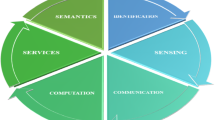Abstract
In this paper, we present some design rules to create a chipless RFID tag that encodes the information in the frequency domain. Some criterions are introduced to make the best choice concerning the elementary scatterers that act like signal processing antennas. The performance of several scatterers will be compared before a study on the radiating properties of a versatile C-like scatterer. An electrical model as well as a transfer function model is presented to best understand the frequency response of both a single-layer and a grounded scatterer. An example of the design and the optimization of a chipless RFID tag based on the use of multiple scatterers are provided, and the frequency optimization step for each resonant peak will be discussed.














Similar content being viewed by others
References
Finkenzeller K (2010) RFID handbook: fundamentals and applications in contactless smart cards, radio frequency identification and near-field communication. Wiley, Chichester
Hartmann C (2002) A global SAW ID tag with large data capacity. Ultrasonics Symposium, 2002. Proceedings. 2002 IEEE, p. 65–69
Mandel C, Schussler M, Maasch M, Jakoby R (2009) A novel passive phase modulator based on LH delay lines for chipless microwave RFID applications. Wireless Sensing, Local Positioning, and RFID, 2009. IMWS 2009. IEEE MTT-S International Microwave Workshop on, p. 1–4
Chamarti A, Varahramyan K (2006) Transmission delay line based id generation circuit for RFID applications. IEEE Microw Wirel Compon Lett, 16:588–590
Shrestha S, Balachandran M, Agarwal M, Phoha V, Varahramyan K (2009) A chipless RFID sensor system for cyber centric monitoring applications. IEEE Trans Microw Theory Tech 57:1303–1309
Vemagiri J, Chamarti A, Agarwal M, Varahramyan K (2007) Transmission line delay-based radio frequency identification (RFID) tag. Microw Opt Tech Lett 49:1900–1904
Zheng L, Rodriguez S, Zhang L, Shao B, Zheng L (2008) Design and implementation of a fully reconfigurable chipless RFID tag using inkjet printing technology. Circuits and Systems, 2008. ISCAS 2008. IEEE International Symposium on, p. 1524–1527
Zhang L, Rodriguez S, Tenhunen H, Zheng L (2006) An innovative fully printable RFID technology based on high speed time-domain reflections. High Density Microsystem Design and Packaging and Component Failure Analysis, 2006. HDP'06. Conference on, p. 166–170
Schuler M, Mandel C, Maasch M, Giere A, Jakoby R (2009) Phase modulation scheme for chipless RFID-and wireless sensor tags. Microwave Conference, APMC. Asia Pacific, p. 229–232
Nair R, Perret E, Tedjini S (2012) Temporal multi-frequency encoding technique for chipless RFID applications. Microwave Symposium Digest (MTT), 2012 IEEE MTT-S International, p. 1–3
Preradovic S, Karmakar N (2009) Design of fully printable planar chipless RFID transponder with 35-bit data capacity. Microwave Conference, 2009. EuMC 2009. European, p. 13–16
Preradovic S, Roy S, Karmakar N (2009) Fully printable multi-bit chipless RFID transponder on flexible laminate. Microwave Conference, 2009. APMC 2009. Asia Pacific, p. 2371–2374
Jalaly I, Robertson I (2005) RF barcodes using multiple frequency bands. Microwave Symposium Digest, 2005 IEEE MTT-S International, p. 4 pp
Jalaly I, Robertson I (2005) Capacitively-tuned split microstrip resonators for RFID barcodes. Microwave Conference, 2005 European, p. 1–4
Mcvay J, Hoorfar A, Engheta N (2006) Theory and experiments on Peano and Hilbert curve RFID tags. Proceedings of SPIE, p. 624808
Vena A, Perret E, Tedjini S (2011) Novel compact RFID chipless tag. Proc. Progress Electromag. Res. Symp, p. 20–23
Vena A, Perret E, Tedjini S (2011) Chipless RFID tag using hybrid coding technique. IEEE Trans Microw Theory Tech 59(12):3356–3364
Vena A, Perret E, Tedjini S (2011) RFID chipless tag based on multiple phase shifters. Microwave Symposium Digest (MTT), 2011 IEEE MTT-S International, p. 1–4
Vena A, Perret E, Tedjini S (2012) A fully printable chipless RFID tag with detuning correction technique. IEEE Microw Wirel Compon Lett 22:209–211
Vena A, Perret E, Tedjini S (2012) High-capacity chipless RFID tag insensitive to the polarization. IEEE Trans Antenn Propag 60(10):4509–4515
Vena A, Perret E, Tedjini S (2012) Design of compact and auto-compensated single-layer chipless RFID tag. IEEE Trans Microw Theory Tech 60(9):2913–2924
Aubert H, Pons P, Chebila F (2010) Measurement device comprising an electromagnetic diffuser. WO Patent WO/2010/136,388
Jang H, Lim W, Oh K, Moon S, Yu J (2010) Design of low-cost chipless system using printable chipless tag with electromagnetic code. IEEE Microw Wirel Compon Lett 20:640–642
Mukherjee S, Chakraborty G (2009) Chipless RFID using stacked multilayer patches. Applied Electromagnetics Conference (AEMC), 2009, p. 1–4
Tedjini S, Perret E, Vena A, Kaddour D (2012) Mastering the electromagnetic signature of chipless RFID tags. Chipless and conventional radio frequency identification: systems for ubiquitous tagging. IGI Global. p. 146–174
Karmakar N (2010) Handbook of smart antennas for RFID systems. Wiley, Hoboken
Balanis C (2005) Antenna theory: analysis and design. Wiley, New York
Acknowledgments
The authors would like to thank Grenoble-Inp for their support via the BQR initiative. The authors also acknowledge the French National Research Agency for financially supporting this project via the ANR-09-VERS-013 program references.
Author information
Authors and Affiliations
Corresponding author
Rights and permissions
About this article
Cite this article
Vena, A., Perret, E. & Tedjini, S. Design rules for chipless RFID tags based on multiple scatterers. Ann. Telecommun. 68, 361–374 (2013). https://doi.org/10.1007/s12243-013-0358-7
Received:
Accepted:
Published:
Issue Date:
DOI: https://doi.org/10.1007/s12243-013-0358-7




